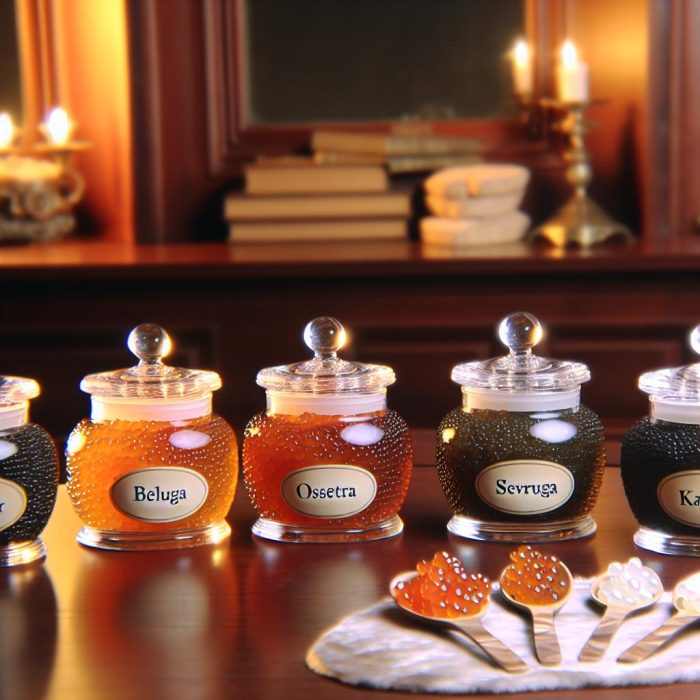Understanding Caviar
Caviar, often synonymous with luxury and elegance, holds a special place in gourmet circles as a delicacy that symbolizes extravagance and refinement. It primarily refers to the salted eggs or roe derived from sturgeon fish, a family of fish renowned not only for their ancient lineage but also for the unique characteristics they lend to caviar. Among various types of fish roe, sturgeon roe stands out as the most prized and highly regarded due to its unique combination of flavor, texture, and aroma.
The essence of fine caviar rests in several intricate details, including its texture and flavor, as well as the methods employed in its production, often steeped in tradition and time-honored practices. For those seeking to indulge in this luxurious treat, or simply looking to experience it for the first time, understanding the nuances and factors that define the finest caviar is essential.
Factors Influencing Caviar Quality
Evaluating the quality of caviar involves considering a variety of factors, each contributing to the distinctive profile of this extraordinary culinary delight. Here’s an exploration of these critical elements:
Species of Sturgeon
One of the primary influencers of caviar quality and character is the species of sturgeon from which the roe is harvested. Each species presents its unique attributes, influencing both flavor and texture. Among the most renowned species are Beluga, Osetra, and Sevruga, each offering a distinct tasting experience.
– **Beluga:** Often described as the most luxurious, Beluga caviar is appreciated for its large, delicate eggs and its creamy, buttery flavor profile.
– **Osetra:** Known for its rich, nutty taste, Osetra caviar is often less abundant than Beluga, making it a premium choice among connoisseurs.
– **Sevruga:** The smallest of the three, Sevruga provides a more intense, briny flavor and is noted for its relatively lower cost compared to Beluga and Osetra.
Method of Processing
The processing method significantly impacts the final taste and presentation of the caviar. Traditional methods involve meticulous selection, salting, and aging, each stage affecting the ultimate quality of the product. Master producers pay close attention to the salting process, often referred to as malossol (meaning “little salt” in Russian), which is crucial in enhancing the natural flavors without overpowering them.
Sustainability Practices
In today’s world, sustainability has become paramount, not only for ethical reasons but also to ensure the longevity of sturgeon populations, which face threats from overfishing and environmental changes. Sustainable practices in caviar production are vital for maintaining the balance between luxury and environmental responsibility. Producers who focus on sustainability emphasize methods and practices that do not deplete natural resources and aim to replenish sturgeon populations.
Renowned Caviar Brands
Several caviar brands have established a name for themselves on the global stage, noted for their commitment to quality and sustainability. Each of these brands has developed a unique approach, honoring traditional methods while incorporating sustainable practices.
1. Petrossian Caviar
Established in Paris in 1920 by Armenian brothers Melkoum and Mouchegh Petrossian, Petrossian is recognized as one of the pioneers in presenting caviar to a global audience. The brand is celebrated for its exquisite selection of both classic and innovative caviar offerings, consistently maintaining high standards of quality. Petrossian’s legacy lies in its deep understanding of caviar and its commitment to excellence.
2. Almas Caviar
Known for its exclusivity and luxury, Almas caviar is harvested from rare albino sturgeons and is one of the most expensive caviars available. Presented in custom-designed tins, Almas has come to symbolize opulence and rarity. Its unique flavor and presentation are tailored for those seeking something truly extraordinary.
3. Caviar Russe
Originating from Russia, Caviar Russe is renowned for its dedication to maintaining traditions of high-quality caviar production. Their products are fashioned with a focus on heritage and innovation, ensuring sustainability with a well-established base in traditional practices. Through selective breeding and harvesting, Caviar Russe ensures that customers experience the rich history and taste of Russian caviar.
The Importance of Sustainable Caviar
With the decline in wild sturgeon populations due to overfishing and environmental pressures, sustainable sourcing has transitioned from being a trend to a necessity. As demand for this exotic delicacy continues to rise, the need to ensure the preservation of sturgeon species becomes ever more pressing. Many caviar producers now invest heavily in sustainable and responsible practices, aiming to safeguard both the industry and the environment.
Several strategies are employed to achieve sustainability in caviar production. Two key practices include:
– **Supporting Hatchery Programs:** by raising sturgeon in controlled environments, these programs boost population numbers and alleviate the pressure on wild stocks.
– **Certified Farms:** certification by organizations like the Aquaculture Stewardship Council (ASC) assures consumers of the farm’s adherence to sustainable and eco-friendly practices, a crucial element in modern caviar production.
Conclusion
In conclusion, appreciation of caviar involves a deep understanding of its multifaceted components, including quality, species, processing methods, and sustainability. For those eager to savor the luxurious sensation of fine caviar, selecting a reputable brand that invests in ethical and sustainable practices is of paramount importance. By recognizing the efforts and traditions upheld by the brands mentioned above, enthusiasts can enjoy the delicacy of caviar not only as a gastronomic pleasure but also as a tribute to sustainability. Through responsible consumption, the legacy of caviar can be preserved for future generations to appreciate and cherish.

